Section 5.1. A Sample Day
5.1. A Sample DayLet's work through a single-day example to see how the system works. When you enter the office each morning, you should immediately focus and start this process. Otherwise, you will be caught by the interruptions and distractions that surround you: your voice mail light is flashing, people are stopping by, the coffee machine is calling you, and you are curious what Dilbert and the group at User Friendly are doing today. You decide to check your email and...hours later realize you've wasted half your day. So STOP. Don't check your email or read the news sites. Instead, close your door (if you are lucky enough to have one) and follow the steps of The Cycle.
5.1.1. Step 1: Create Today's ScheduleYou begin the day by setting up today's schedule. You're going to look at your calendar to see what meetings and appointments you've committed to and use that as the basis to mark out blocks of time on your daily schedule. The remaining time can be used to work on your to do list. You'll use the power of arithmetic to calculate how much time you have. Let's pretend you look at your calendar and see the items in Figure 5-1. Figure 5-1. Calendar appointments It looks like you have one-hour meetings at 10:00 a.m. and at 3:00 p.m. Therefore, you block out those times on today's schedule. You also like lunch, so you block out noon to 1 p.m. Next, you calculate how much time you have left for your to do list. It is 8:30 a.m., and you want to leave at 5:30 p.m., or in about nine hours. With three hours already blocked out, you are left with six hours to allocate to your remaining tasks. Figure 5-2 shows you what the day already looks like. 5.1.2. Step 2: Create Today's To Do ListNow you create the list of to do items that are on your plate for today and calculate how much work (in hours) you have. Normally, you'd have some items already scheduled. You'll add any others that come to mind (that brilliant idea you had while walking through the parking lot), and if this is the first day of the month, you'll process your life-goals list (more about that in Chapter 7). Since this is the first day you're using The Cycle, your to do list is blank. However, you can add some items that you know you have to do. Write them in your own shorthand, not full sentences. When you write it into the to do list, it looks like Figure 5-3. As you can see, the shorthand only has to be enough for you to understand the task. You can record as many other details, such as phone numbers, usernames, etc., as you think are necessary, but try to keep it succinct. Figure 5-2. A day with blocked-out time Figure 5-3. Mondayto do items in your organizer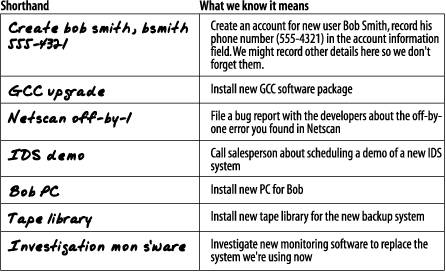 If you have voice mail waiting, this is a good time to listen to it and transcribe any messages. I tend to write down an item for each message that I get, even if the message requires no action on my part. In that case, I can mark the item as "done" right then and there. It gives me a feeling of accomplishment. How much work do you have today? Use a column in the to do list to write an estimate of the time each item will take (Figure 5-4), and then total the estimates. Figure 5-4. Mondaytime estimates added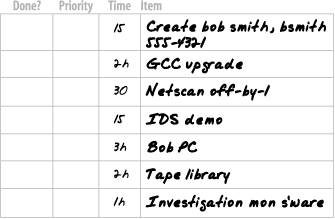 In this example, you can count the hours items (marked with an "h") quickly to see there are eight, and then total up the fractional parts (unlabeled times are in minutes) and find that they total one hour. Therefore, the amount of work on your to do list totals nine hours. 5.1.3. Step 3: Prioritize and RescheduleNext, you mark each item based on a simple priority system. I tried a priority system in which I ranked items from 1 to 100, and it was too complicated. A friend pointed out that there are really three priorities in life:
For the sake of simplicity, let's call these A, B, and C tasks, and that's how you will mark the tasks on your priority list. Figure 5-5 shows you how I have prioritized tasks for this first day. Figure 5-5. Mondaypriorities added 5.1.3.1. Dealing with overflowYou have nine hours of tasks on your to do list, but only six hours of time to spend working on them. How can you handle the overflow? The wrong thing to do is to stay late. Your social life is valuable. You don't do your employer any favors by ignoring social time and becoming irritable. You work better when you eat right, get plenty of sleep regularly, exercise, and participate in nonwork activities. The easiest thing to do is to shift the C priorities and enough of the B priorities to the next day. That's one of the benefits of having one to do list assigned to each day. We can move items around. Here are some ideas that work well:
Back to our example to do list: Let's move low-priority tasks to the next day. You have one C priority called "Investigate mon s'ware." Let's move this to the next day. If you are using a PDA, you bump the entry to the next day's list. If you are using a PAA, mark the entry with a hyphen to indicate that it was moved, and hand copy the entry to the next day's to do list. You've reduced today's workload by one hour. You still need to eliminate two more hours. Luckily, you also have a B priority (GCC upgrade) that can be moved to the next day. You move it the same way as you did the C priorities (PDA: bump it; PAA: mark it with a hyphen in today's list and handwrite it into tomorrow's list). Now your list looks like Figure 5-6 and matches your number of available hours. Figure 5-6. A fully loaded Monday with overflow priorities moved to Tuesday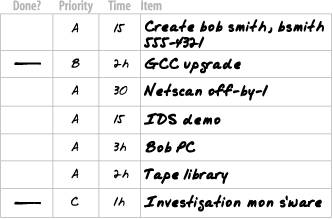
5.1.4. Step 4: Work the PlanSpend the day working as close to the plan as possible. First do the A items, then the B items, and then, if you have time, the C items. It can be useful to have some kind of alarm or reminder to tell you when your meetings and appointments are so that you don't have to keep interrupting yourself to look at the clock. When you finish one task, start on the next task. Keep the momentum going. Many people have told me that they spend a lot of time trying to decide what to do next. A simple solution is to do all the A priorities in the order they appear on the list, and then do the same with the Bs and the Cs. We'll improve upon that system in Chapter 8, but for now, you can't do too badly by just doing them in order. The items higher on the page tend to be things that were copied from previous days. In other words, items you've put off tend to bubble up to the top of the list and will get taken care of first. Try to take advantage of your momentum by moving onto the next task after you complete a task. Do this even if a task took less time than you had planned; it will make up for time lost when another task takes longer than expected. Once in a while, pause to stretch. If you finish a task early, take a quick walk around the building. Being in IT generally means you don't get enough exercise. Carry a file folder so it looks like you are on your way to something importantnobody will be the wiser. Once you've finished all your As, start working on the Bs. If you finish those, congratulate yourself by working on the most fun C item on the list. 5.1.5. Step 5: Finish the DayIt's rare that you will complete everything on your to do list, but you do want to make sure that the items are all managed. An item is managed if you've given it sufficient attention on that day. A half-hour before the end of your day, look at the remaining items. If there are any As that aren't complete, you need to manage that situation. Call the person expecting the task to be completed and come up with a contingency plan. Or, if these are self-imposed deadlines (and they often are), copy the items to the next day. In our example, you had enough time to unpack your tape library, make sure it came with the right cables, and even pantomime the process of mounting it in the rack to make sure the cables would reach and so on. However, you weren't able to find anyone to help you lift it into the rack. Therefore, you managed the item by noting what you did accomplish (checking off the items) and copying the remaining parts of the project to the next day. With a PDA, you would bump the item to Tuesday's list. With a PAA, you can write in "unpacked and checked" next to the item, mark it with a hyphen, and write "mount tape library" on Tuesday's list. Any remaining Bs and Cs should also be moved to the next day. In our example, there aren't any to be moved because we moved them already. Our lists now look like Figure 5-7. As you can see, it took us six hours to complete five hours of tasks. Figure 5-7. Monday's to do list at the end of the day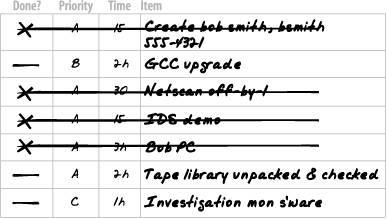 5.1.6. Step 6: Leave the OfficeFigure 5-7 shows a list on which every item in the Done? column has a mark. You've managed every item on your list. No, they aren't all completed, but they were managed. Sometimes managing an item means making sure it got the appropriate amount of attention; for low-priority items, that means they were moved to tomorrow. The important thing is that they were not forgotten. You can look at your to do list and get the satisfaction of knowing you've managed everything on your plate today. Congratulate yourself. Smile. Put your coat on and go home happy. You deserve it. I used to leave work every day feeling terrible. I felt like I had worked and worked, but I felt no sense of accomplishment. When I use The Cycle, I'm able to look at my list of items, see that each one was managed, and feel closure. I can leave the office with a smile on my face. 5.1.7. Step 7: RepeatLet's pretend it's Tuesday. You can repeat The Cycle with today's list of items. Today I'll introduce some advanced topics and show you how to manage them. In particular, you'll see how The Cycle works with a request-tracking system, voice mail messages, and interruptions. 5.1.7.1. Create today's scheduleYou should start each day by checking your calendar for any appointments and filling them into your day's schedule. Today you have no meetings, so your hour-by-hour schedule is blank except for one hour for lunch, which leaves you eight hours for work out of your typical nine-hour day. So far, so good! 5.1.7.2. Create today's (Tuesday's) to do listYesterday, four new tasks were added to your plate. Let's call them Task1, Task2, Task3, and Task4. They're low-priority tasks delegated to you during the staff meeting. They were not as important as the tasks you had to do yesterday, so you recorded them directly onto the first to do list that you thought was realistic, which happened to be today's (Tuesday's). This is in addition to the tasks that you managed yesterday by placing them on today's to do list. When you arrived at your office today, your voice mail light was flashing, so you listened to the three messages and recorded them in your to do list, even if they didn't require any action. It turns out that the first one was a company-wide notice about the east entrance of your building being blocked. You're so glad they're wasting time for everyone in the company because obviously you would never have realized what all the construction equipment and the big freakin' signs that say East Exit Closed could possibly have meant. Since this doesn't require any action from you, you promptly cross the item out. The next message is from your Cisco salesperson. You record the number, since you're going to call him back (but before you cross out the item, you will verify that your contact databasedescribed in Chapter 12has the same number listed). The third message is a salesperson cold-calling you. You're not going to return that call, so you just write "junk" and mark an X in the Done? column. Your Tuesday list now looks like Figure 5-8. The day hasn't started, and you've already completed two items! You rule! You might be wondering why you write down a task that you immediately mark as completed. You do this because it becomes a log of your phone calls, which can be a good "cover your ass" measure. This is one reason I prefer a PAA to a PDA. With a PAA, it's less effort to write junk items that immediately get crossed off. Figure 5-8. Tuesdayafter listening to your voice mail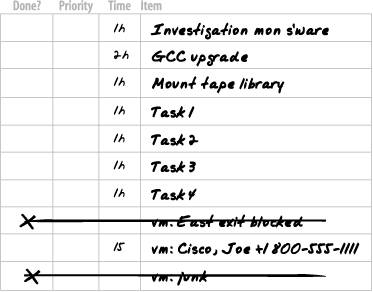 I've already mentioned a couple of times that having some kind of request-tracking system is a good idea. How do you handle that in The Cycle System? You designate a specific amount of time each day to work on your tickets. I once had a job where I was expected to spend one-third of my day working on such requests. Therefore, every day I added a two-hour task called Tickets to my list. I wouldn't handle those tickets only during a two-hour block in the morning, but rather I used Tickets as a time holder for those moments in the day when I needed to work on tickets because one of them had become an unexpected priority. I also get a lot of interruptions, about one hour's worth a day. These interruptions are an important part of serving my customers' needs, so I also allocate time for them.
Now you can calculate how many hours of work you have to do, and it turns out to be 11.25 hours! With only 8 hours to do 11.25 hours of work, it's time to prioritize. Any "due today" items immediately become A priority. The tape library issue was an A yesterday, which we half-completed. Therefore, finishing that task is obviously an A priority today. 5.1.7.3. Prioritize and rescheduleHow do you prioritize the Tickets and Interruptions items? Well, they have to be done every day, so they should be As. However, Interruptions is sort of a buffer just in case you are interrupted, so you can be flexible and mark that item as a B. There are a few Bs and lots of Cs (which is normal). Thus, you have something that looks like Figure 5-9. Figure 5-9. Tuesday's tasks after filling in all time estimates and priorities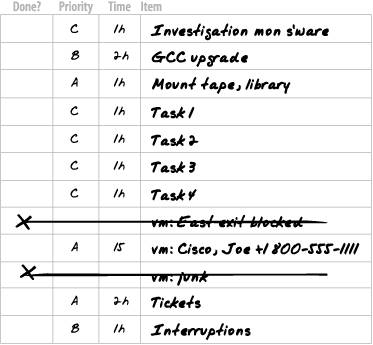 Yesterday, the sum of the As and Bs was more hours than could fit into your day, so you had to use our techniques to shift work to the next day. Today, the sum of the As and Bs is only 6.25 hours. Because that will fit in your eight-hour day, there isn't any overflow that we have to move. I've found that if I only have a few As and complete them early in the day, the rest of the day is more relaxed. I do my Bs and as many of the other tasks as possible, and when the end of the day comes, I move the incomplete work to the next day without guilt. It's a lot less stressful this way, and it allows me to deal with interruptions a lot better. Let's use that technique today. You won't slide any tasks onto Wednesday's to do list right now. As you'll see, you'll do that at the end of the day, if necessary. 5.1.7.4. Work the planNow you work on the As until they are complete. Working on tickets might generate more action items for you. For example, if a request is not going to be completed in one sitting, you can add it to your to do list. Let's say ticket #43001 from RT involves fixing a nightly batch job and then verifying that the fix worked. You can fix the problem, then create a to do item on the next day to verify that the change fixed the problem (Figure 5-10). Figure 5-10. Adding a request-tracking ticket to Wednesday If another ticket involves ordering software and installing it, you might order the software today and then write an item for the day that you expect it to arrive. I use my organizer to track any ticket that I'm actively working on. The list of tickets that I own, however, is much longer; therefore, I don't include them in my personal to do list. I use my to do list only to track the things I'm actively working on and things that I need to do on a specific date in the future.
Next, you work on the Bs. Since Interruptions is a buffer, you don't have to stand around doing nothing if nobody interrupts you. 5.1.7.5. Finish the day and leave the officeAt the end of the day, you spend a few minutes managing the remaining items. The tasks that haven't been completed are moved to the next day, and you leave the office with a smile on your face knowing that you've managed all of your tasks. |
EAN: 2147483647
Pages: 117
